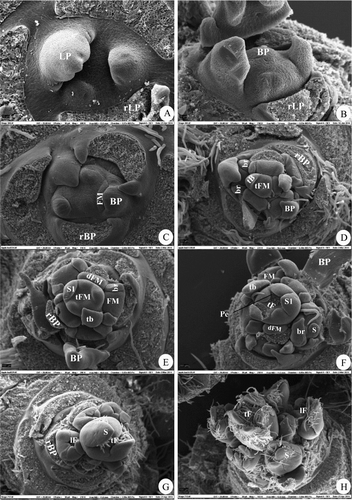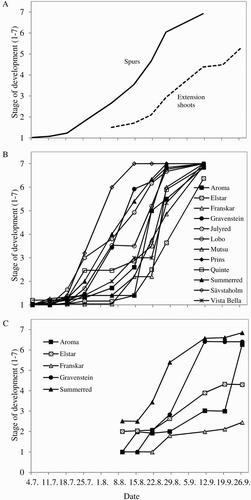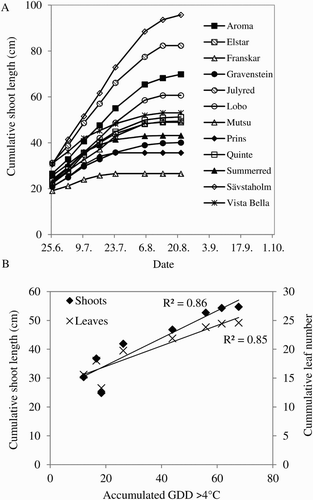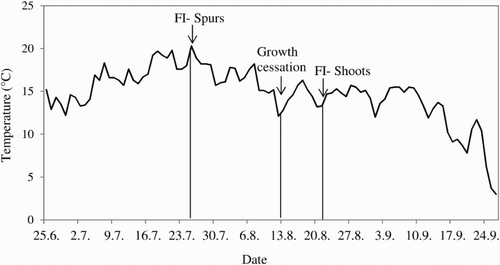Figures & data
Figure 1. Annual variation in the earliness of the occurrence of the spring phenology stage ‘full bloom’ for cultivar ‘Gravenstein’ at Ås, Norway, during the period 1946–2016. The regression lines for the two time phases (1946–1966 and 1966–2016) denote correlations between the number of days for the occurrence of full bloom and progression of time (calendar years). The parallel April–May heat sums are included for comparison.

Figure 2. Regression analysis of the relationship between spring heat accumulation (GDD > 4°C for April and May) versus days after April 1 for the occurrence of full bloom stage (FB) in cultivar ‘Gravenstein’ for the 70 years’ period 1946–2016.

Figure 3. Annual variation in the occurrence of the spring phenology stage ‘full bloom’ for 12 apple cultivars at Ås, Norway, during the period 1986–2016. Triangles and the connecting line denote mean number of days after 1 May, and small circles show the variation among the cultivars.

Table 1. Cultivar differences in the occurrence of the flowering phenology stages ‘pink’ and ‘full bloom’ among 12 apple cultivars at Ås, Norway, during the period 1986–2016.
Figure 4. Stages of floral morphogenesis in spurs of ‘Summerred’. (A) Narrow, flat apex (stage 1). (B) Domed apex with bract primordia (stage 2). (C) Inflorescence meristem and floral meristems with bracts (stage 3). (D) Terminal and lateral floral meristems with bractlets (stage 4). (E) Terminal and proximal floral meristems with sepals (stage 5). (F) Terminal floral meristem with initiated petals and lateral floral meristems with initiated sepals (stage 6). (G,H) All floral meristems with sepals (stage 7). LP, leaf primordium, rLP, removed LP, BP, bract primordium, rBP, removed BP, tB, terminal bract, FM, floral meristem, tFM, terminal FM, dFM, distal lateral FM, br, bractlet, S, sepal, tF, terminal (king) flower, Pe, petal.

Figure 5. Time courses of floral morphogenesis for 12 apple cultivars in an experimental orchard at Ås, Norway, in the year 2013. (A) Total averages including all cultivars. (B) Individual cultivar curves for spurs. (C) Individual cultivar curves for extension shoots. For spurs, each data point represents the mean of five buds per cultivar; and for extension shoots, the mean of all buds of three shoots per cultivar.

Table 2. Periods of floral development in spurs and extension shoots of 12 apple cultivars grown in an experimental orchard at Ås, Norway, in the year 2013.
Figure 6. Relations between progress of spring phenology stages (GT, P, FB) and April–May temperature for 12 apple cultivars in an experimental orchard at Ås, Norway, in the years 2013 and 2014. (A) Occurrence of the respective stages as related to April–May heat accumulation. Coefficient of determination (R²) for the linear regression is shown for each curve. (B) Daily mean temperatures during floral development to blooming. The occurrences of the respective stages are indicated for each curve. (C) Diagram of relationships between cultivars based on standardized GDD data for bud-break. Distance on the Y-axis shows the similarity level between clusters (0 = dissimilar, 100 = identical).

Table 3. Accumulated GDDT = 4°C (growing degree days at a base temperature of 4°C) at which the stages of bud-break green tip (GT), pink (P) and full bloom (FB) occurred in 12 apple cultivars in 2013 and 2014 in an experimental orchard at Ås, Norway.
Figure 7. Shoot growth in 12 apple cultivars grown in an experimental orchard at Ås, Norway, in the year 2013. (A) Growth curves for each of the cultivars. (B) Relation between shoot length and accumulated number of leaves versus summer heat accumulation. Coefficient of determination (R²) for the linear regression is shown for each curve.


